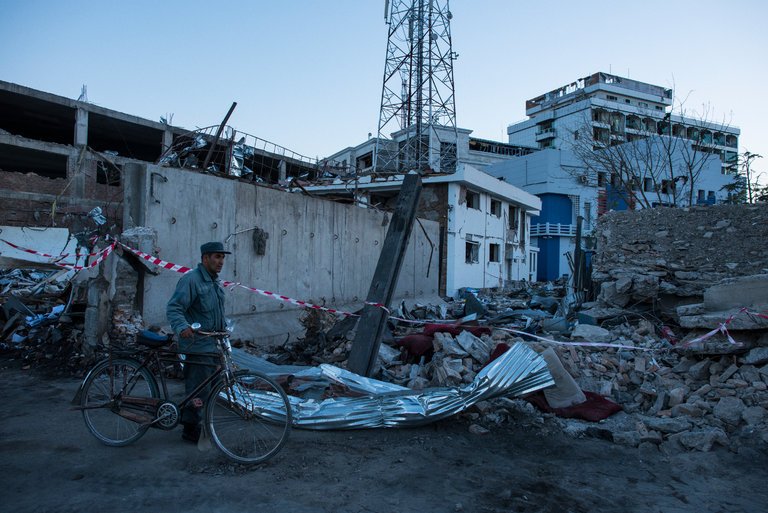Kabul- Soon, American Embassy employees in Kabul will no longer need to take a Chinook helicopter ride to cross the street to a military base less than 100 yards outside the present Green Zone security district.
Instead, the boundaries of the Green Zone will be redrawn to include that base, known as the Kabul City Compound, formerly the headquarters for American Special Operations forces in the capital. The zone is separated from the rest of the city by a network of police, military and private security checkpoints.
The expansion is part of a huge public works project that over the next two years will reshape the center of this city of five million to bring nearly all Western embassies, major government ministries, and NATO and American military headquarters within the protected area.
After 16 years of American presence in Kabul, it is a stark acknowledgment that even the city’s central districts have become too difficult to defend from Taliban bombings.
But the capital project is also clearly taking place to protect another long-term American investment: Along with an increase in troops to a reported 15,000, from around 11,000 at the moment, the Trump administration’s new strategy for Afghanistan is likely to keep the military in place well into the 2020s, even by the most conservative estimates.
No one wants to say when any final pullout will take place, because the emphasis now is on a conditions-based withdrawal — presumably meaning after the Afghan government can handle the war alone. But President Trump has kept secret the details of those conditions, and how they are defined.
“Until he says what the conditions are, all that means is we’ll be there as long as we want, for whatever reason we want,” said Barnett Rubin, a longtime Afghanistan expert who advised the Obama administration. “And they don’t have to lie to do that, because the conditions will never be good enough to say we’re absolutely not needed.”
In practical terms, it means that the American military mission will continue for many more years, despite its unpopularity with the American public. Many military strategists, in America and Afghanistan, have already penciled in plans well into the ’20s, and certainly past any Trump re-election campaign.
At the NATO summit meeting in Warsaw last year, the allies, including the United States, agreed to fund the development of the Afghan security forces until the end of what was termed “the transition decade,” meaning from 2014, when Afghan forces began to take charge of their own security, until 2024.
“I would guess the US has to plan on being inside Afghanistan for a decade or more in order for there to be any type of resolution,” said Bill Roggio, editor of Long War Journal. “It’s definitely past his first term in office, no two ways about it.”
The Green Zone expansion is aimed at making it possible for America and its NATO allies to remain in the capital without facing the risks that have in the past year made Kabul the most dangerous place in Afghanistan, with more people killed there than anywhere else in the country — mostly from suicide bombers.
Kabul’s security area had long been a Green Zone-lite compared with its fortresslike predecessor in Baghdad, where there are massive blast walls and a total separation from the general population, enforced by biometric entry passes.
In Kabul, thousands of Afghans still commute to jobs and even schools inside the zone, with only light searches for most of them, mindful of the resentment stirred by the Soviets’ heavily militarized central zone during their Afghan occupation. And the Green Zone in Baghdad has, its critics maintain, created an out-of-touch ruling class and Western community, and provided a magnet for protests while just moving enormous bombings elsewhere, further stoking popular discontent with leaders and foreigners.
The Kabul Green Zone expansion, which will significantly restrict access, was prompted, according to both Afghan and American military officials, by a huge suicide bomb planted in a sewage truck that exploded at a gate of the current Green Zone on May 31, destroying most of the German Embassy and killing more than 150 people. The loss of life could have been far worse, but Germany had evacuated its embassy a week before the bombing, apparently tipped off by intelligence sources.
The military recently appointed an American brigadier general to take charge of greatly expanding and fortifying the Green Zone. In the first stage of the project, expected to take from six months to a year, an expanded Green Zone will be created — covering about 1.86 square miles, up from 0.71 square miles — closing off streets within it to all but official traffic.
Because that will also cut two major arteries through the city, in an area where traffic congestion is already rage-inducing for Afghan drivers, the plans call for building a ring road on the northern side of the Wazir Akbar Khan hill to carry traffic around the new Green Zone.
In a final stage, a still bigger Blue Zone will be established, encompassing most of the city center, where severe restrictions on movement — especially by trucks — will be put in place. Already, height restriction barriers have been built over roads throughout Kabul to block trucks. Eventually, all trucks seeking to enter Kabul will be routed through a single portal, where they will be X-rayed and searched.
The New York Times
